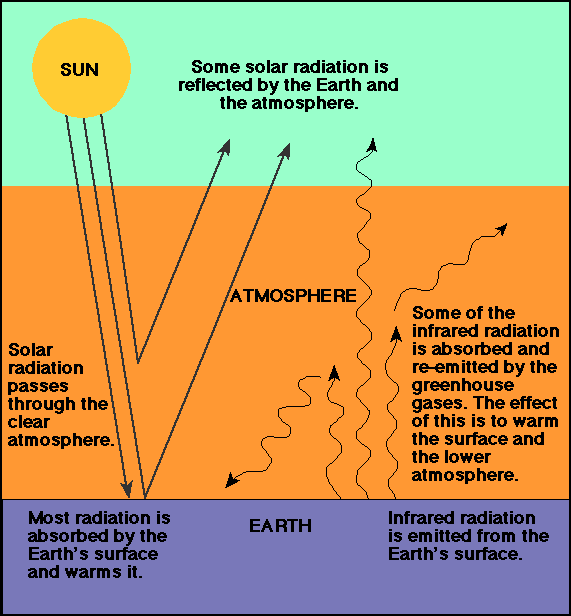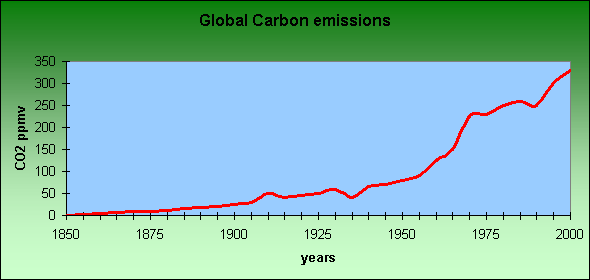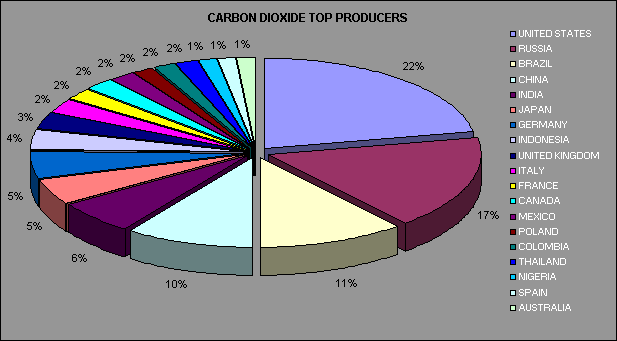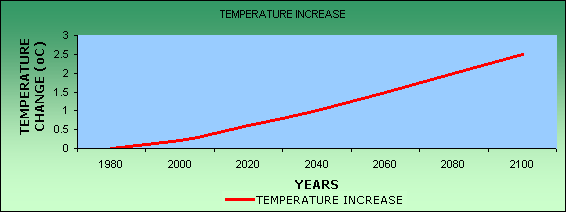

| The greenhouse effect |
Everyone knows the prediction that the “greenhouse effect” will modify the climates around the world.
I°) THE MECHANISM OF THE GREENHOUSE EFFECTThe earth’s surface and atmosphere are kept warm primarily by energy from the sun.
The phenomenon that worries environmental scientists is that increasing the concentration of the trace gases in air that absorb thermal infrared light would results in the redirection of even more of the outgoing thermal infrared energy and would thereby increase the average surface temperature beyond 15°C. This phenomenon will be referred to as the enhanced greenhouse effect, to distinguish its effects from the one that has been operating naturally for millennia.
In the next picture we can observe a schema of the operation of the greenhouse effect in the earth’s troposphere .


In your mind, which contry produces the greatest quantity of greenhouse gases ?


The combined greenhouse effect enhancement from the increases in concentration of the trace gases methane, nitrous oxide, ozone and the CFCs is now almost as large as that from the increases in carbon dioxide. In order to conveniently summarize the temperature- enhancing effects of all greenhouse effects gases by a single number, the concept of an Effective Carbon Dioxide concentration has been divised.
An increase in the average atmospheric temperature means that more energy is contained in the air and water at the earth’s surface, and that more violent weather disturbances could result
According to the projections made in 1992 by the Intergovernamental Panel on Climate Change (IPCC), they made an analisys and predicted that if no additional stepd are taken to reduce emissions of CO2 and other problematic gases, then by about the year 2040 the average global air temperature will be 1°C higher than the present. By 2100 it will increase by still another 1.5°C. The total amount of global rainfall increase, although there will be regions that will receive less rainfall than before these changes took place. Annually, The number of days having intense rain showers or very high temperatures both will increase.



Sea levels will rise by about 18 cm by 2040 and by 48 cm by 2100, effects due mainly to the thermal expansion of seawater and the melting of glaciers. Although this increase in the sea level may seem small, there are countries such Bangladesh in which much of the population currently lives on land that would be flooded by a rise in the sea level of only about 50 cm. Temperature and misture changes will occur quickly compared to those that have taken place in the past, and consequently some ecosystems will be destabilized.

The temperature increase will probably be greater close to the Polar Regions. There may well be enough melting of ice in the artic region for the Northwest Passage to be used for commercial transport. In subtropical areas, the monsoon rains will likely be heavier. Also will be probably will have more extreme heat waves in summer and fewer prolonged cold snaps in winters. There will be longer frost-free growing seasons at northern latitudes, but increased changes that heat stress will affect crops grown there.
All these changes in the stratosphere could cause an impact over the human health, the scientist have predicted that the human will be affected by the greenhouse effect, for example, the expected doubling in the annual number of very hot days in temperature zones will affect people who are especially vulnerable to extreme heat, such as the very young, or the very old, and those having chronic respiratory diseases, heart disease, or high blood pressure.
Now we are going to describe the main consequences of the greenhouse effect :
The increase of the temperatures will cause an increase in death and illness, especially among the urban and the urban poor people, with limited access to the air aconditioning.
A recent study of many of diffrents regions in Europe showed that the populations have adjusted successfully to mean summer temperatures lie between 13.5°C and 24.1°C, and while heat-releated mortallity started around 17.3°C in the north Findland, it first set in at 22.3°C in London, and 25.7°C in Athens.
At the same time, all populations showed much greater deaths in winter time, and thus even a small decrease in winter deaths would greatly outweigh a small heat death increase.
With a temperature increase diseases as the Malaria, can appear again, it is due to because the mosquitoes that transmit the malaria ordinarialy need winter temperatures between 16-18°C.
We have observed, on the scale of the Earth, a reheating of a half degree over the last century, with the records of temperature reached during the 1980's. However, it is still difficult to say if these events are the first signs of a reheating of the climate.
The reheating observed during the last century is the subject many scientific debates. The last results of the models show that it could be the consequence of the various industrial wastes and agricultural products by the man.
But it could just as easily reflect a natural variation of the climate, in particular the end of the cooling of the previous centuries, known under the evocative name of "small Ice Age".
Some scientists estimate we must still await ten years at least before being able to affirm that we live indeed a climatic change.